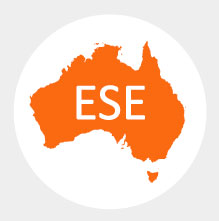
Tools and workflow development for Electronic Scholarly Editing
Paul Eggert was joint CI with Jane Hunter of UQ in the AustESE project, funded by the Federal Government’s NeCTAR funding scheme for 2012-2013 with development continuing in 2014. More fully described at http://austese.net it involves the design of a workflow and tools for electronic scholarly editing. It welcomes new participants.
AustESE is the latest in a series of ASEC initiatives and joint initiatives in digital editing. The history of the development of the Just In Time Markup (JITM) system is given next.
Background
This JITM initiative developed in parallel with the Academy Editions of Australian Literature series, the Centre's main project.
Discussions began from 1993 and a team was put together: Paul Eggert (co-ordinator), Phill Berrie (programmer at ADFA), Chris Tiffin (at UQ) and Graham Barwell (at UWoll). It worked on and off over the next 12 years, on and off, as funding was available.
At issue in the early discussions was the form or forms an electronic scholarly edition could feasibly take, using the text files being generated by the Academy Editions project as its archive, and what resources would be needed to realise the concept. This built on three years of development of MacCASE, the collation software for comparing versions of works. Developed over three years with the cooperation of the ADFA Computer Centre, the editorial collation software, MacCASE, was released in 1995. The program was extensively tested and refined during the collation of volumes for the Academy Editions series. Phill Berrie was the programmer. MacCASE was designed with Macintosh operating systems in mind. With the demise of OS 9 the software was no longer supported and is now unavailable.
The initial plans were published in Computers and Texts (Oxford); No. 8 (December 1994), pp. 5-7.
Funded by the AVCC Working Group on Electronic Publishing, a pilot electronic edition of part of Marcus Clarke's His Natural Life was shown to audiences of scholars in Sydney and Canberra in 1996. It incorporated for the chosen section several versions of the novel in text and facsimile, two film versions of the section, a song and other materials. The scripting was in HTML. Development in SGML-TEI continued.
The Centre organised a 5-day workshop, 9-13 December 1996, at ADFA, on electronic scholarly editing. Dr. Peter Robinson (Oxford) conducted the workshop. An open seminar on issues of text-encoding formed part of the week's activities. Another workshop was organised in 1998 for a Dante electronic-commedia project.
In 2000-2001 the project was renamed: AUTHENTICATED ELECTRONIC EDITIONS
With the available funding an electronic edition of His Natural Life was completed: see JITM
In 2004 an ARC special projects grant to the Australian Academy of the Humanities allowed the work to resume. By now the authentication of textual transcriptions using stand-off markup that is inserted Just In Time had been perfected. This project proved that it also facilitates collaborative interpretation of the text but without endangering the authenticity of the textfile itself.
The testbed was the bushranger Ned Kelly's famous Jerilderie Letter of 1879. See the electronic edition of it, with two sets of annotation and introductions at JITM
Download the JITM Software
New software that allows already marked-up text files to be used under the Just In Time Markup system and to be the subject of further interpretation was also developed. It is called JITAM: Just In Time Authentication Mechanism. Download it at http://hass.unsw.adfa.edu.au/ASEC/current_projects/jitm/JITAM/index.html
Papers about JITM
For discussions of what JITM facilitates, see
- Paul Eggert, 'Text-encoding, Theories of the Text, and the "Work-site"', Literary and Linguistic Computing, 20 (2005), 425-35 and at Oxford Journals.
- Phill Berrie, Graham Barwell, Paul Eggert and Chris Tiffin, 'Authenticating Electronic Editions', in Electronic Textual Editing, ed. Lou Burnard, Katherine O/Brien O'Keeffe and John Unsworth (New York: Modern Language Association, 2006), pp. 436-48
For other papers on the project click here